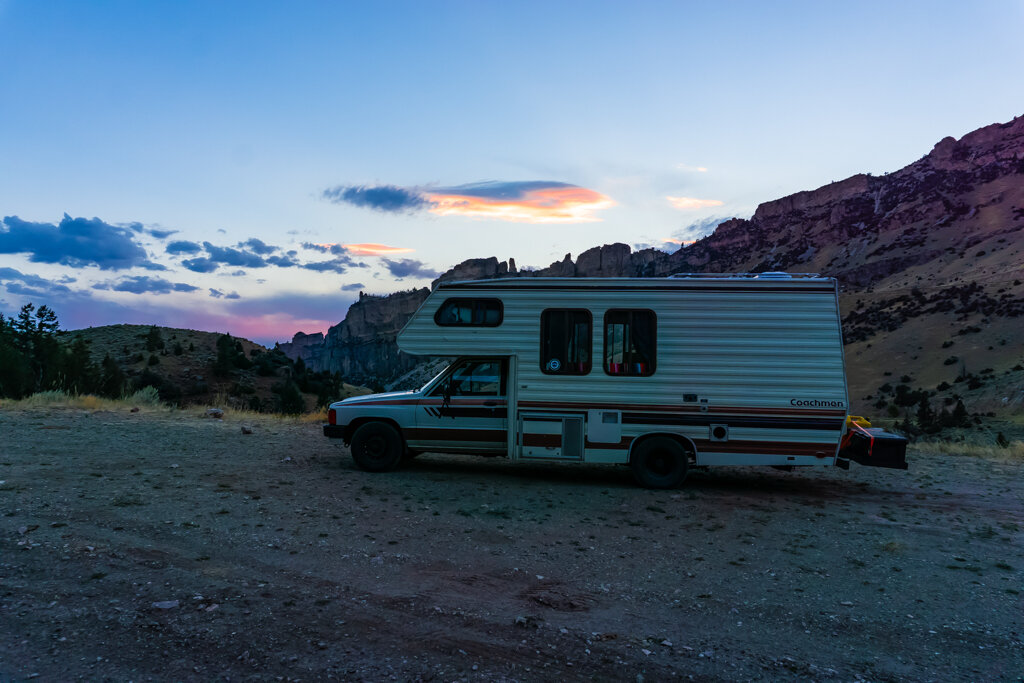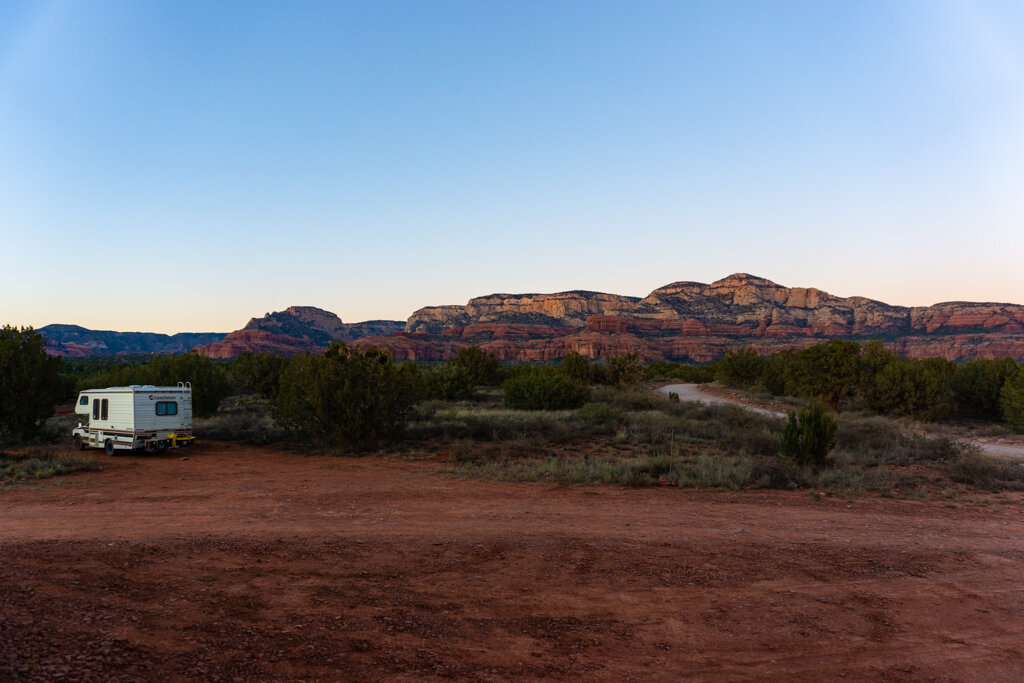The most common questions I get about RVing full-time is about safety... so today I wanted to cover boondocking safety tips!
For those of you who are new to the wonderful world of RVing full-time - welcome! If you travel by van, bus, truck camper, or even car... these boondocking safety tips are important for you too.
One of our favorite boondocking sites ever, located in Bighorn National Forest. Just before this photo was taken.. we suddenly lost brake pressure on this mountain road and had to stop for a while and troubleshoot.
What is Boondocking?
Boondocking is a term used to describe off-grid camping (with no hookups!), which is usually both free and very remote. While boondocking, most of the time you'll be camping on public land. BLM land and national forests are the most common, but across the country you'll find pieces of land that are maintained by different national or local agencies as well.
The best part about boondocking is that these spots allow you the true camping experience... free of campground rules, nosy neighbors and squished parking-lot like campsites. Some of the most beautiful places we've ever experienced were while we were boondocking. (Check out this post about Bighorn National Park in Wyoming for our #1 favorite free campsite ever!)
If you need help finding these locations... I put together a free 5 page guide on how to find the best free campsites! (Get your free download here!)
Another free boondocking spot in Sedona, Arizona. We found so many gems while RVing full time!
Boondocking Safety
Since all of the best campsites are in remote locations, it's very important to be prepared when traveling into the wilderness. Before RVing full-time - I came up with a million scenarios where things could go wrong while in remote areas. After 20,000 miles of travel - I can happily say that none of those scenarios ever happened. We were never attacked by a wayward ax murderer, or chased by bears. Our RV, Yoda, never even got a flat tire.
Unfortunately, not everyone will get so lucky - so it pays to be prepared. Here's a list of boondocking safety tips that we (almost) always lived by while RVing full-time!
Boondocking Safety Rule #1: Walk the Road Before You Drive
My first boondocking safety tip is to scout all dirt access roads before driving on them. Even though I find this rule to be pretty damn important, we didn't often practice it (and got ourselves in some super sketchy situations because of it). Even though a road may look fine going in - you may run into areas where it gets rutted, washed out or even dangerously narrow with steep drop-offs and nowhere to turn around.
In our travels, we found ourselves in situations where we were forced to drive through a river, up a mountain road so rutted that all 4 of our wheels could not touch the ground at the same time, and on a mountain track that was barely wide enough to accommodate our RV with a drop-off so gnarly that I could not look out the window without feeling sick. Thankfully, Tim grew up in a hick town where wheelin' was common - so his maneuvering skills are spectacular. Please learn from our mistakes and practice safe boondocking! ALWAYS SCOUT YOUR ROADS.
This was one road that we DEFINITELY should not have taken our RV on - but probably would have tried. ALWAYS scout roads before you drive them, getting stuck is a good way to ruin a trip.
Boondocking Safety Rule #2: Check the Weather & Elevation
This tip is coming at you from another place where we seriously screwed up. Being from the east coast, elevation and weather are not something that we saw a correlation between until we got caught in some dangerously cold weather at a high altitude in Utah, just outside of Bryce Canyon.
If you're RVing full time - the last thing you want is for your plumbing and pipes to freeze due to cold temperatures. Even when days feel relatively warm, ALWAYS check the nighttime temperatures and weather conditions before you drive 20 miles down a forest access road to find a campsite.
Additionally, knowing your elevation while boondocking can be important when it comes to using propane appliances. At elevations over 7,000 feet, propane may not fully combust due to less oxygen content in the atmosphere. This can cause an increased risk of carbon monoxide poisoning. Whether you live in an RV, van or bus, make sure to install a carbon monoxide and propane detector before you hit the road.
If you look closely - you can see a veil of smoke over the mountaintops. This was due to a wildfire in Grand Teton National Park that was caused by negligent humans. DON'T BE THAT GUY.
Boondocking Safety Tip #3: Understand Your Surroundings - Especially When it Comes to Wildlife & Wildfire
In every boondocking area that you travel to.. it's important to understand your surroundings and the potential hazards that come with the area. One of the most important things to be aware of is the fire risk in an area. A large part of our country is dry, and can easily catch fire given the opportunity. When entering an area, pay close attention to the "fire danger" signs posted. If the risk is high, it's best to avoid campfires. And always, ALWAYS make sure to put your fires out properly. This website gives a good explanation of the fire danger ratings if you're unfamiliar!
In addition to being aware of possible fire danger, it is important to be aware of wildlife in your area - mainly, bears. If you're in bear country.. be sure to store your food properly, to avoid leaving trash or anything with an odor outside, and to carry bear mace.
Another favorite free boondocking site of ours. This was reported as being a great place to watch Grizzlies. Although we didn't spot any, we took the necessary boondocking safety precautions to avoid any dangerous situations!
Boondocking Safety Tip #4: Always Carry Extra Fuel, Fluids & Food
This is the prepper in me talking... but in the name of boondocking safety - you should always carry extra fuel (gasoline, propane, ect.), fluids (for your vehicle and yourself), and food.
I recommend extra fuel and mechanical fluids (motor oil, transmission fluid, brake fluid, antifreeze) because while traveling we've ran out and needed to refill all of these at unexpected times. Luckily for us, most of our fluid troubles were in Walmart parking lots (so thankful!)... but after the first time, we realized that it's better to take up the extra space than to risk running out of fuel or transmission fluid in a remote area. (Keep in mind, we travel in a 34-year-old Toyota RV which can be very unpredictable due to her age! If you’re lucky, your vehicle may be a little bit less high maintenance)
Carrying extra food water and is also really more for peace of mind that IF IN THE RARE CASE you get stuck somewhere, you'll have resources to keep you afloat while you figure out a solution. Even though we don't drink from our RV's fresh water tank - knowing that we have a large amount of water on board always makes us feel more secure. Additionally, I like to keep a life straw and water purification tablets on board, and in my backpack when we leave the RV to explore.
Boondocking Safety Tip #5: Carry A Spare Tire & A Shovel
The last safety tip I have is that you should always keep a spare tire with you, as well as the tools needed to change that tire. Our RV didn't come with one, and we planned to pick one up while traveling - but never did. This always worried me, and I would not advise traveling into remote areas without one. Having AAA is great, but most of the best boondocking sites have no cell service to call someone for a tow.
Having a shovel on-board is also a good practice, which will help with getting your rig un-stuck if you happen to bury it in and or other soft ground.
One Last Request from a Fellow Boondocker
If you're camping on public lands, or any other boondocking areas - PLEASE, PLEASE, leave these areas better than you found them so future nomads will continue to have access to these spaces. LEAVE NO TRACE is a very important practice that will ensure the integrity of the land.
Also, if you happened to access these free campsites though an online forum or app (if you don't know which ones to use - download my free camping guide, for FREE - right here), and found the access road or campsite to be closed or damaged.. please update the listing for future travelers. Your contribution will help save others from the stress of driving to a remote area only to find out they can't stay there.
Did I Miss Anything?
If you're RVing full time.... or part time, or if you've ever been boondocking at all, I have a question for you. Did I miss any important boondocking safety tips? If so, help me and other travelers out by leaving your tip in the comments below!





